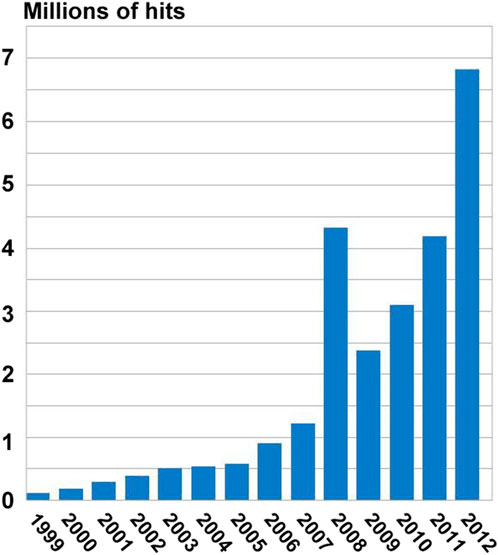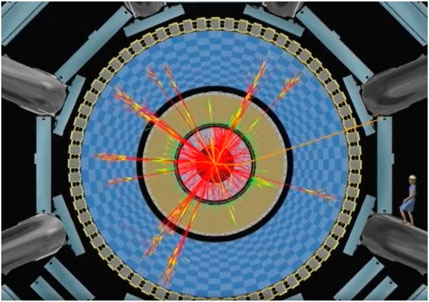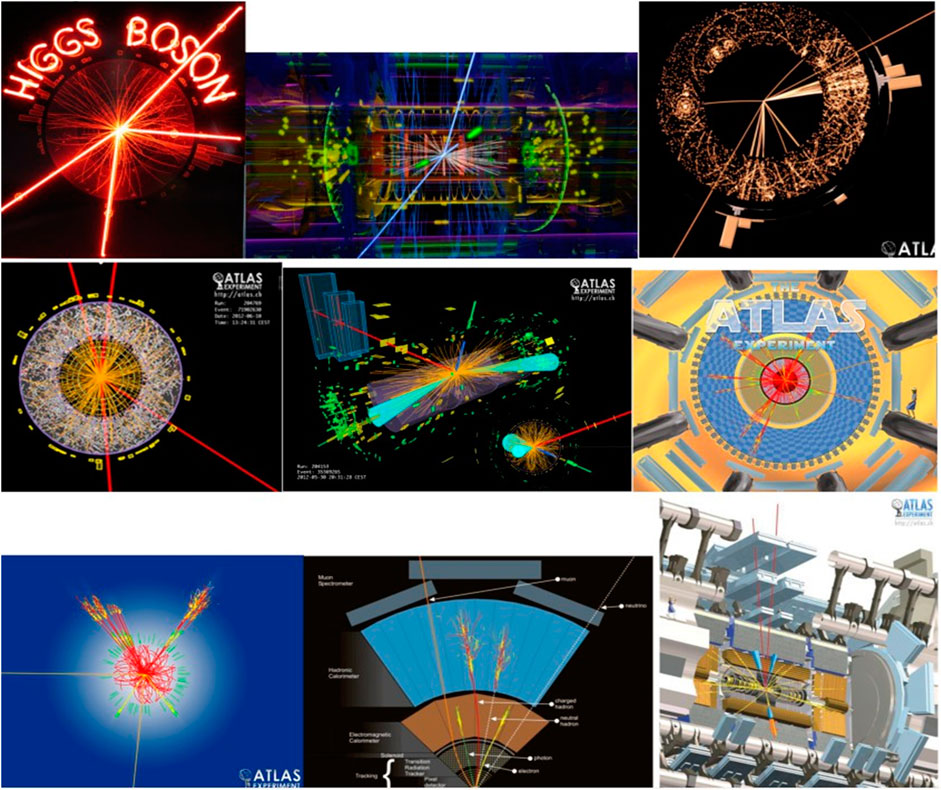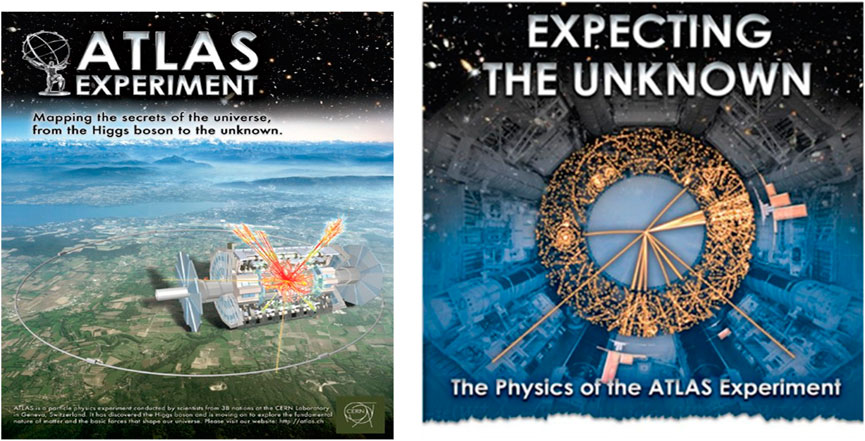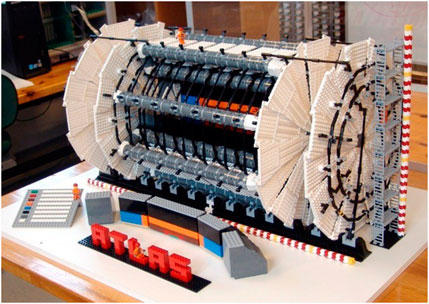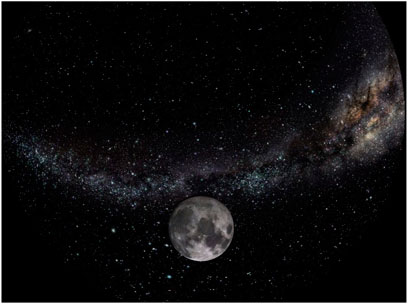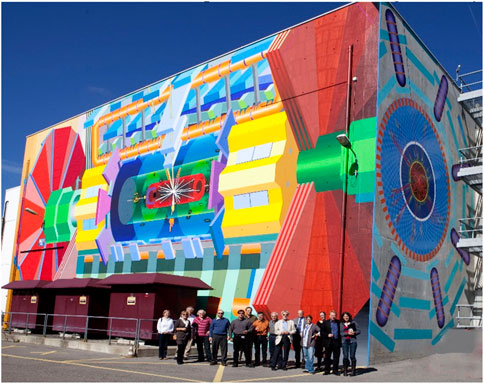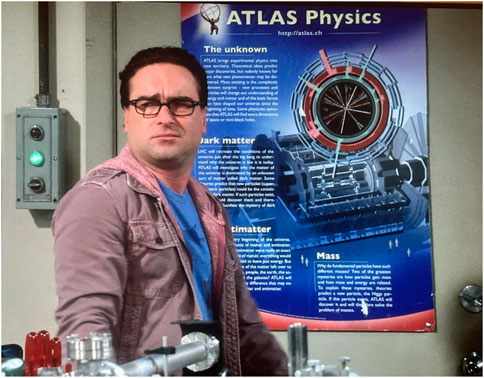- 1Lawrence Berkeley National Laboratory, Berkeley, CA, United States
- 2Department of Physics, Stockholm University, Stockholm, Sweden
In 1995, the ATLAS Experiment at the Large Hadron Collider embarked on an ambitious journey, driven by a passion to ignite curiosity and inspire future scientists. Our quest wasn’t just about uncovering the universe’s mysteries; it was a cosmic odyssey to share the thrill of scientific exploration with all. Our exploratory collection included engaging classroom activities, a dynamic website, captivating videos, a vibrant YouTube channel, global social media connections, and a captivating planetarium show, all intertwined with the exciting search for the elusive Higgs Boson. This scientific program celebrates the enduring curiosity of humanity and the passion that fuels discovery.
Introduction
At the Large Hadron Collider (LHC) [1], a renowned facility perched on the French-Swiss border near Geneva, brilliant minds embark on a ceaseless exploration of the universe’s enigmatic mysteries, infusing the halls of CERN with the promise of unveiling the cosmos’s hidden truths. The inception of the ATLAS Experiment’s [2] education and outreach project was born from the desire to share the thrilling drama that defines groundbreaking science. Its mission: To ignite curiosity within students, inspire them, and pave the way for the next-generation of scientists.
Large hadon collider
The Large Hadron Collider (LHC) is the world’s largest and most powerful particle accelerator. It is located at CERN (the European Organization for Nuclear Research) near Geneva, Switzerland, and extends across the border between Switzerland and France. The LHC is a circular tunnel with a circumference of about 27 km, buried roughly 100 m underground. The tunnel houses two parallel beam pipes, each containing a high-energy beam of particles (usually protons) that travel in opposite directions. The two particle beams are steered around the ring and focused to a size of 20 μm (the size of a thin hair) at the collision points by superconducting magnets.
The LHC and the experiments therein were built to explore fundamental questions in physics by recreating the conditions of the universe just after the Big Bang, allowing scientists to study the basic building blocks of matter and the forces that govern their interactions.
The ATLAS and CMS Experiments at the Large Hadron Collider have significantly deepened our understanding of the universe, confirming key aspects of the Standard Model and opening new avenues of research into the unknown. The technologies developed for the LHC have had broader impacts, driving advancements in areas like medical imaging, information technology, and materials science.
ATLAS experiment at the Large Hadron Collider
ATLAS is the largest of the particle physics experiments situated around the particle ring. The collision point is situated in the centre of the detector, which has the shape of a lying cylinder 46 m long and 26 m in diameter. With the large number of particle detectors specialised to detect, identify and determine the energy of the particles produced in the particle collision, the particle collisions can be reconstructed, and the underlying physics processes can be explored.
The ATLAS Experiment is a monumental scientific instrument, designed to explore the fundamental particles and forces of nature. Its discoveries have already reshaped our understanding of the universe, and its ongoing research continues to push the boundaries of knowledge in physics. ATLAS and the LHC are products of global collaborations, involving thousands of scientists, engineers, and technicians from hundreds of institutions around the world.
The ATLAS Experiment has achieved several significant results since it began operating. The most famous result from the ATLAS experiment is the discovery of the Higgs boson, announced on 4 July 2012, in collaboration with the CMS experiment. This discovery confirmed the existence of the last missing particle predicted by the Standard Model of particle physics, explaining the mechanism by which particles acquire mass.
Following the Higgs boson discovery, ATLAS has made detailed measurements of the Higgs boson’s properties, including its mass, spin, and interactions with other particles. These measurements are crucial for understanding the nature of the Higgs boson and testing the predictions of the Standard Model.
In addition, ATLAS has conducted extensive searches for new particles predicted by theories beyond the Standard Model, such as supersymmetry (SUSY) particles, dark matter candidates, and extra dimensions. These searches have set stringent limits on the possible characteristics and masses of these hypothetical particles. ATLAS has made precise measurements of the top quark’s properties, including its mass, production cross-sections, and interactions with other particles. These measurements are important for testing the Standard Model and understanding the role of the top quark in electroweak symmetry breaking.
ATLAS has observed several rare processes predicted by the Standard Model, such as the production of pairs of W bosons and Z bosons, and the production of Higgs bosons in association with top quarks. These observations provide further validation of the Standard Model and offer insight into the interactions of fundamental particles. ATLAS has studied CP violation, a difference in the behavior of particles and antiparticles, in B meson decays. Understanding CP violation is crucial for explaining the matter-antimatter asymmetry in the universe.
These results represent just a fraction of the extensive research conducted by the ATLAS experiment. The ongoing analysis of data from the LHC continues to probe deeper into the mysteries of the universe, potentially leading to new discoveries in the future.
The education and outreach program of the ATLAS experiment
In the mid-90s, the physicists at the LHC’s ATLAS Experiment made a pivotal decision. We aspired to create an ambitious education and outreach program that resonated globally. Ready to invest our dedication, we sought to reach the general public and students, exposing the physics of ATLAS and showcasing how experiments unveil cosmic mysteries. With physicists from more than 40 nations working together ATLAS embarked on an unmatched journey to share the excitement of scientific frontiers with a global audience.
Our goal was to translate captivating stories into universally understandable tales. Many dedicated individuals contributed to the ATLAS Education and Outreach initiative during this era (see Acknowledgements). The program continues unabated to this day, captivating the inquisitive public, teachers, students, and thousands of CERN visitors (more than 60,000), all fascinated by contemporary physics. We have had substantial impact among scientific magazines, the news media (both print and television/radio) and bloggers.
This article describes the period 1996–2012, when ATLAS outreach began, a work that is still ongoing.
The impact of the ATLAS education and outreach program
In order to describe and explain the fundamental processes in particle physics, we wanted to use the many techniques available to produce interesting material for education and outreach purposes and highlight some of the most exciting explorations of the ATLAS experiment. This included giving students the possibility to explore the particles and processes using real particle collision data from ATLAS. The impact of this effort is described in the following 13 short sections.
Website
The ATLAS website is the portal to most of our education and outreach information for students, teachers, and the public. The peak in 2008 was due to the startup of the Large Hadron Collider and a large amount of media attention. This website had almost 7 million hits in 2012 (an average of 132,000 hits per week). Through 2012, there were a dramatic 26 million hits on atlas. ch website (which has been renamed as atlas. cern). See the distribution in Figure 1. The site had 700 webpages at that time.
There were specialized webpages for the news media and for students and teachers. The press page contained in compact form interesting images and video accompanying the physics news releases and developments. The student/teacher pages had everything from fun pages to the student event analysis sites.
The Discovery Quest introduced readers to the potential discoveries that motivate the experiment, covering: dark matter, supersymmetry, the origin of mass, extra dimensions, antimatter, new forces, the unknown, as well as the Standard Model. The ATLAS eTours had sections on physics, experiment, and accelerator. Together they encompassed 60 pages. The information on social media answering basic questions of physics, the nature of the collaboration and the people in ATLAS have constantly grown over time. The ATLAS Run and LHC run section provided the latest information about the accelerator and particle collision live events, as well as access to relevant photos, videos and DVDs.
From this single website portal, one could discover an amazing world of information about ATLAS and about physics.
Videos
One of the formats for communicating science produced by the ATLAS education and outreach group were many videos about the physics and the construction, operation, and experimental techniques. We even mounted a camera on a giant toroid magnet as it was lowered into the cavern far underground.
Two early animations (in Star Wars style) were.
ATLAS – Episode 1 – A New Hope.
ATLAS – Episode 2 – The Particle Strike Back.
Among the many videos was the so-called “ATLAS Experiment Movie”. This movie won Gold Medals at four international film festivals (produced in ten languages). It gives a glimpse behind the scenes of building the ATLAS detector. This film asks:
• Why are so many physicists anxious to build this apparatus?
Will they be able to answer fundamental questions such as:
•Where does mass come from?
• Why does the Universe have so little antimatter?
• Are there extra dimensions of space that are hidden from our view?
• Is there an underlying theory to find?
Major surprises are likely in this unknown part of physics.
YouTube channel
Another mode of communicating science was the ATLAS YouTube channel at YouTube.com/TheATLASExperiment. It had 38 videos (of 86 videos produced by ATLAS Outreach). The top one had 134,000 viewings. In total, there were 840,000 viewings as of 2012. Eleven clips were rated as five stars (highest). Some of the resulting comments from viewers were:
• Very awesome channel … Cheers!!!
• Wow I love your channel!! It’s awesome!
• Great channel.
• Wow!!!
Exploring particle collision events: a hands-on experience
By studying particle collisions at very high energies, the ATLAS experiment is exploring how particles are produced and how the fundamental processes affect the inner structure of matter. One of the main aims of ATLAS has been to shed light on what mass is. This has for a long time been a mystery. The prevailing theory at the time (the Brout-Englert-Higgs mechanism, sometimes just called the Higgs mechanism) described a mechanism that gives rise to mass. This mechanism predicted the existence of a particle, the Higgs particle. Finding and observing the Higgs particle was the confirmation of the mechanism that gives rise to mass.
A lot of the material we produced in the outreach group aimed at describing the detector and how it is used to explore the normally hidden processes in microcosm. But particularly for teachers and students we wanted to go further and explain the dynamics of the constituents of matter, and make students involved in the exploration of particle collisions.
When two protons collide at high energy, it is inside the protons that the real action is taking place. It is the constituents of the protons, which are the quarks and gluons, that interact. Our aim was to intrigue and inform students and teachers with these fundamental processes in the interior of matter [3]. One of the most important ingredients in this education effort was actual particle collisions that students could study.
Particle collisions are dramatic, Figure 2. A large amount of energy is concentrated on the two particles colliding in the middle of the ATLAS experiment. In the very early universe, when it was only a fraction of a nanosecond old, these particle collisions dominated. In images and films, we exhibited the intensity of these dramatic particle collisions. In ATLAS Episode 2 (https://videos.cern.ch/record/1096390) the particle collision is accompanied by dramatic music similar to that of Star Wars.
Short-lived particles in ATLAS
In the high energy particle collisions a large number of particles are produced. Among this multitude of particles, some particles originate from the decay of particles produced in the collision that leave no tracks. To reconstruct these invisible particles is something a student can manage to do with some help from a physicist.
The decay point of particles with lifetimes around 10−10 s can be reconstructed with the precise information of the detector data. The decay can be visualised, and the event can be analysed with reconstruction techniques that the students can learn with some guidance, see Figure 3. Quantities like electric charge, mass and lifetime can be determined [4].
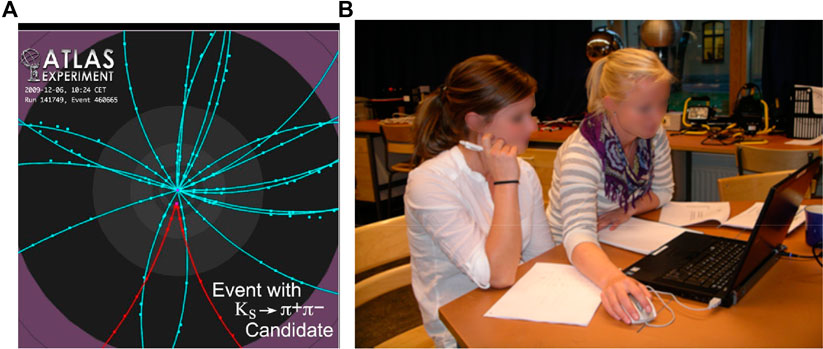
Figure 3. (A) A neutral short-lived particle decaying into a positive particle and a negative particle in the Inner Detector of ATLAS (red particle tracks). (B) Students in Stockholm House of Science exploring the decay of short-lived particles produced in ATLAS.
A similar technique can be used to search for and reconstruct the elusive Higgs particle. A difference is the extremely short lifetime of the Higgs particle, which is so short that it will decay practically immediately, and the decay point will be invisible.
The Higgs particle
One of the main aims of the ATLAS experiment was to shed light on the origin of mass and to ultimately find the Higgs particle. Many of the products of the education and outreach group, like the artistic particle collision images, the physics brochure as well as other education material, focused on the search for the Higgs particle.
Similar techniques that are used to reconstruct and explore particles with lifetimes around 10−10 s are used to reconstruct the extremely short-lived Higgs particle. An animation of the dynamics involved in the production and decay of the Higgs particle can be seen in [5]. The people visiting ATLAS and the students taking part in the Masterclasses get a chance to learn more about the Higgs particle and the dynamics behind the origin of mass.
After a long search, the discovery of the elusive Higgs particle was announced in 2012 by the ATLAS and CMS experiments [6]. The discovery resulted in an increased interest in ATLAS, which can be seen in the huge number of website hits that year. Today the ATLAS mural is adorned with a collision event in which a Higgs particle has been produced.
Figure 4 shows a particle collision in which a Higgs particle has been produced.
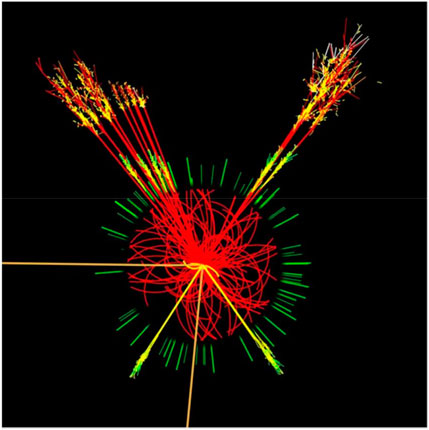
Figure 4. An ATLAS collision event in which a Higgs boson was produced and quickly decayed to the particles observed in the detector.
Learning with the ATLAS experiment
Our aim was to present contemporary physics at school to enthuse students and teachers about today’s frontline physics and support the members of the collaboration in their education and outreach activities. In addition to informational material like films, animations and brochures, several analysis programs were created for high school students to make it possible for them to analyze samples of actual ATLAS events, which were tested at worldwide masterclasses (ATLAS Resources [7]).
With these tools, students can explore the same particle collisions that thousands of scientists around the world use in their research. Experimental data from the ATLAS Experiment have also been made available for students and teachers participating in the International Masterclasses in particle physics [8]. The International Masterclasses [9] now attract around 13,000 college students from around 60 countries every year.
For a long time, the ATLAS education and outreach project has collaborated with the International Masterclasses [9] and the International Particle Physics Outreach Group [10] to make it possible for students to take part in the exploration of particle collision data. This education collaboration is still very much active and continues to expand.
Pop-up book, a special event, and news coverage
We worked with author Emma Sanders and artist Anton Radevsky to create a spectacular pop-up book for the public. It was introduced at a well-attended special event that was held at the New York Academy of Science in the World Trade Center building that survived the 2001 attack. It featured actor Alan Alda as host, and Lisa Randall, Michael Tuts, Emma Sanders, and Anton Radevsky as speakers. See Figure 5.
There was news coverage of pop-up book in Los Angeles Times, Discovery Channel, PC World, Gizmodo and more. Gizmodo’s headline said:
“This is Simply the Coolest Pop-up Book We’ve Seen.”
Giant mural and news coverage
We commissioned mural artist Josef Kristofoletti to produce a three-story mural (2010) of the ATLAS detector near the control room. The ATLAS mural has attracted huge attention, see e.g., Figure 6.
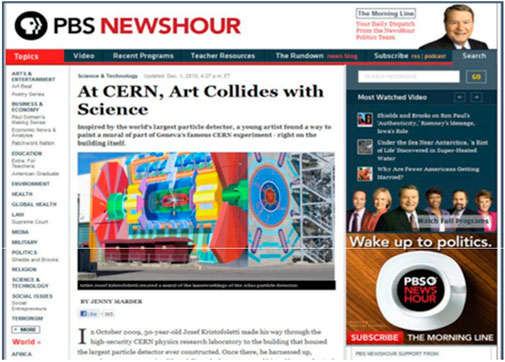
Figure 6. ATLAS mural in PBS Newshour (also New York Times, the Guardian, and many other news media).
Artistic views of ATLAS collision events
We have created multiple types of views of ATLAS collision events, such as those below. The aim is to attract and enthuse our audiences with the nature of our data. See Figure 7.
A multitude of printed materials
ATLAS created many printed materials in addition to the Pop-up book, including brochures: General, Physics, Tech Transfer, Technical Challenges, Extra Dimensions, Computing, Fact Sheets, and press kit. Our general brochure changed the appearance of how brochures look. It was a big “hit” and reprinted again and again, see Figure 8.
Photoshop contest with many entries
ATLAS Outreach organized a Photoshop contest for the public using a classic photo of ATLAS under construction. It produced many amazing images, such as these in Figure 9:
LEGO model of the ATLAS detector
ATLAS Outreach developed a LEGO Model of the ATLAS experiment with almost 10,000 pieces (Figure 10). 68 institutions worldwide have constructed this model for display.
Planetarium show
A planetarium show developed and produced by ATLAS members has had massive impact (Figure 11).
It is in more than 840 planetariums in 75 countries and has been translated into 27 languages.
It has been seen by more than 2 million people. At an International Full Dome Festival, the show won an award for Outstanding and Innovative Production. See the show’s website at: https://phantomoftheuniverse.org/The planetarium show “Phantom of the Universe” explores the mysterious dark matter, which is believed to be the dominating component of matter in the Universe. This unknown matter could be due to particles searched for by ATLAS and other experiments at the Large Hadron Collider.
The show covers dark matter from the Big Bang to galaxies to underground searches to the LHC and ATLAS. It is a state-of-the-art show with an Academy Award winning narrator for the English version, Tilda Swinton. Since the producers had no experience with planetarium shows, we choose real professionals. Among them were a Hollywood scriptwriter and a Hollywood producer. Sound was handled by Skywalker Sound, which has won Academy Awards for their work. We consulted with experts from seven planetariums.
The ATLAS visitor centre at CERN
The ATLAS Visitor Center is an arena for education and outreach, using informational material described in this article. It is situated close to the ATLAS mural and next to the ATLAS control room. The ATLAS mural is a good meeting point for visits to ATLAS (Figure 12). About 30,000 people a year pass through the visitor centre.
The particle collisions take place 100 m under the visitor’s feet in the underground cavern of the ATLAS detector. The visits to the ATLAS Visitor Centre are often guided by research students, who also describe their own role in the experiment. The guides efforts are commonly supplemented by the live views of the ATLAS control room with the physicists busy verifying that all the detector components are functioning correctly.
Cultural impact
Our efforts also had cultural impact in many areas where physics is not commonly found.
Angels and Demons movie
A major Hollywood movie, Angels and Demons, with Tom Hanks had 5 min about the Large Hadron Collider, and much was filmed inside the ATLAS cavern. ATLAS Outreach worked with Sony Pictures to create an extra segment about the ATLAS experiment on the DVD of the movie. We travelled to their studios near Hollywood to organize and plan the DVD extra segment. We also created a website for the physics of Angels and Demons, an antimatter booklet, and a PowerPoint template for talks centered around the movie and ATLAS. See. Figure 13.
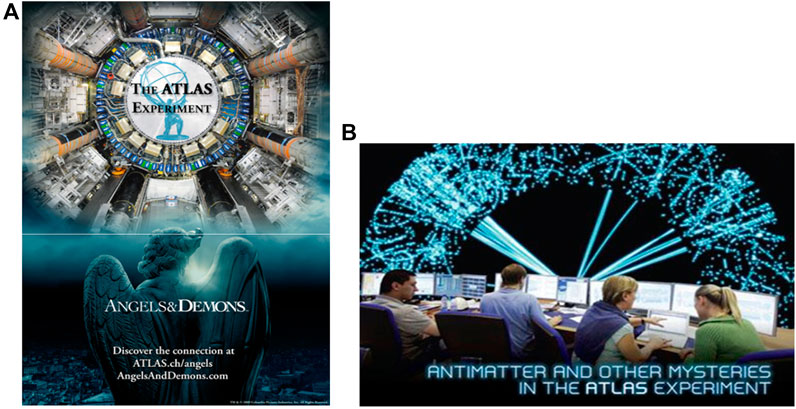
Figure 13. (A) The ATLAS website for Angels and Demons related materials, and (B) The Antimatter Booklet.
Berlioz opera
Our efforts also had cultural impact in an opera: The backdrop of a scene in the opera “Les Troyens” by Hector Berlioz was an adaptation of a photo of the ATLAS detector under construction. This opera was shown in Valencia, St. Petersburg, and Warsaw.
Muppets movie
In a 2011 movie partly filmed in the ATLAS cavern, the Muppets go to CERN. In the movie, Kermit the Frog sets to reunite his gang of muppets, and his journey takes him all the way to CERN.
The Big Bang Theory show
The Big Bang Theory comedy show, where two physicists explain the mysteries of physics, was aired on CBS from 2007 to 2019. It received several Emmy awards. Figure 14 shows the ATLAS physics poster in the TV show.
PhD comics
The famed author of PhD comics, Jorge Cham, made some comic strips about ATLAS describing a young physicist’s role in this army of scientists and enormous amount of data.
Scientific American article on ATLAS art
“19 Ways that Art and the LHC Open a Portal to Physics”
The 19 images of the Scientific American art article [11] show the different artistic expressions used to visualize the dynamic nature of exploring particle collisions and the secrets of microcosm.
Variety of media impact
Injecting excitement with an aesthetic touch in the presentation of the ATLAS Experiment seems to have caught the attention of a variety of media and also inspired a variety of formats. An opera, a Hollywood movie, a Muppet movie, a TV comedy show and a comics series demonstrate that ATLAS has made it to arenas where physics is not commonly found.
The ATLAS education and outreach project
Exploring new routes for outreach in ATLAS
The aim of the outreach ATLAS outreach project was to ignite curiosity and inform the international community about particle physics and the ATLAS experiment using the most recent technology. New brochures with an interesting look using graphic photos of the detector were produced. These photos quickly spread, appearing in newspapers and magazines, and even in the decor of an opera.
Animations of particle interactions showing the numerous particles emerging from the collision played an increasingly important role in describing the dynamics of particle collisions.
Achievements of education and outreach in the ATLAS experiment website and YouTube site
The public website was the hub for most of the information about the ATLAS experiment and the physics that ATLAS was exploring. There were typically 3 or 4 million hits per year, but with the discovery of the Higgs boson in 2012, it jumped to 7 million, showing the importance of the website to students and the public. Together with the ATLAS YouTube site, it formed a popular and important site for thrilling information about particle physics.
Exploring particle collisions
One of the most appreciated projects were the animated particle collisions and the artistic views of particle collisions. They were frequently used by the ATLAS community in interactions with students and the public, and were seen in many magazines and TV programs.
For students there was a more hands-on project to explore particle collisions, particularly the production of short-lived particles. The exploration of particles having a lifetime of 10−10 s was the first step to explore events with a Higgs particle having a very much shorter lifetime.
The analysis programs are still in use in International Masterclasses [9] for the analysis of the W and Z particles, the mediators of the weak force.
Lego model and mural
The production of a Lego model and the painting of the ATLAS mural are two very different projects showing the ATLAS detector. 68 institutions worldwide have constructed the Lego model for display. Tens of thousands of visitors have passed the large mural on their way to the ATLAS visitor centre.
Planetarium show
The successful planetarium show, involving many people with different skills, is rather unique for ATLAS. It has been seen by over 2 million people in 840 planetariums in 75 countries and exists in 27 languages.
Collaborating with other experiments and outreach organisations
The aim of the International Masterclasses and the International Particle Physics Outreach Group (IPPOG) to make it possible for high school students all over the world and the interested general audience to learn about the processes inside matter, coincided with that of the ATLAS education and outreach project. This resulted in a long and close collaboration between ATLAS, the International Masterclasses and IPPOG to make it possible for students to take part in the hands-on exploration of particle collision data. This collaboration is still going on and expanding.
The success of the education and outreach project within the ATLAS collaboration and the media inspired other experiments. A dynamic outreach community was formed with CERN and many of the experiments at the LHC accelerator.
Conclusion
During 1996–2012 the education and outreach project in ATLAS was formally established and soon became an integrated part of the experiment. The ATLAS education and outreach program has continued to this day, and has made many major advancements, including those in social media, exhibitions, virtual visits and classrooms visits. This process has continued to spread, resulting in education and outreach activities having become a natural part of international physics projects.
i. Today all major physics experiments have an outreach project integrated in the collaboration - a revolution in frontline physics education and outreach, which we are happy to have been part of.
ii. Future experiments now often have an ambitious education and outreach project. Many research councils now require applicants to have an education/outreach project in their research application.
iii. Most particle physics conferences now have an education and outreach session.
The education and outreach project of ATLAS has described how the ATLAS experiment has explored, and still is exploring the inner structure of matter and some of the mysteries we still encounter. Our ambition was to make the images and stories understandable and available to everybody, sometimes more detailed and challenging for teachers and students, but always aesthetically interesting.
Injecting excitement with an aesthetic touch in the presentation of the ATLAS Experiment have caught the attention of a variety of media. In addition to appearing in journals and magazines, ATLAS has made it to arenas where physics is not commonly found, like an opera, a Hollywood movie, a Muppet movie, a TV comedy show and a comics series.
Students and the general public are excited and motivated by learning about the amazing developments in contemporary physics. We are happy to have been part of this fascinating endeavour together with so many of our ATLAS colleagues.
Author contributions
RB: Conceptualization, Funding acquisition, Project administration, Resources, Writing–original draft, Writing–review and editing. KJ: Conceptualization, Project administration, Writing–original draft, Writing–review and editing.
Funding
The author(s) declare financial support was received for the research, authorship, and/or publication of this article. Financial support was received from the ATLAS collaboration for the education and outreach project described here.
Acknowledgments
During the period of this report (1996-2012), the education and outreach program benefitted from the outstanding work and contributions of many people, including Hans Peter Beck, Uta Bilow, Helfried Burckhart, Laurent Chevalier, Manuela Cirilli, Juliette Davenne, Kaushik De, Markus Elsing, Jean Ernwein, Pauline Gagnon, James Gillies, Steve Goldfarb, Neal Hartman, Michael Hauschild, Dirk Hoffmann, Vato Kartvelishvili, Michael Kobel, Christine Kourkoumelis, Josef Kristofoletti, Alison Lister, Amelia Maio, Fabienne Marcastel, Claudia Marcelloni, Katie McAlpine, Sascha Mehlhase, David Milstead, Alexander Oh, Joao Pequenao, Ceri Perkins, Connie Potter, Emma Sanders, Paul Schaffner, Reinhard Schwienhorst, Chris Thomas, Josiane Uwantege, Bob van Gijzel, Peter Watkins, Tiina Wickstroem, Monika Wielers. Katie Yurkewicz. With apologies to those people we may have forgotten. After 2012, the Education and Outreach program has had outstanding contributions from additional people. We also had the great support of Peter Jenni in particular, but also Torsten Åkesson, Dave Charlton, Fabiola Gianotti, Marzio Nessi, Markus Nordberg, and ATLAS management in general.
Conflict of interest
The authors declare that the research was conducted in the absence of any commercial or financial relationships that could be construed as a potential conflict of interest.
Publisher’s note
All claims expressed in this article are solely those of the authors and do not necessarily represent those of their affiliated organizations, or those of the publisher, the editors and the reviewers. Any product that may be evaluated in this article, or claim that may be made by its manufacturer, is not guaranteed or endorsed by the publisher.
References
1. CERN. The Large Hadron Collider (2024). Available online at: https://home.cern/science/accelerators/large-hadron-collider (accessed October 1, 2024).
2. ATLAS Experiment (2024). Available online at: https://atlas.cern/ (accessed October 1, 2024).
3. Barnett RM, Johansson KE. The Education and Outreach Project of ATLAS – a new participant in physics education. Phys Education (2006) 41:432–6. doi:10.1088/0031-9120/41/5/008
4. Barnett RM, Johansson KE, Kourkoumelis C, Long L, Pequenao J, Reimers C, et al. Learning with the ATLAS experiment at CERN. Phys Education (2012) 47:28–37. doi:10.1088/0031-9120/47/1/28
5. ATLAS Experiment. ATLAS Higgs ZZ animation (2015). Available online at: https://www.youtube.com/watch?v=wZpfHzlhuzg&t=3s (accessed October 1, 2024).
6. Aad G, Abajyan T, Abbott B, Abdallah J, Abdel Khalek S, Abdelalim AA, et al. Observation of a new particle in the search for the standard model Higgs boson with the ATLAS detector at the LHC. Phys Lett B (2012) 716:1–29. doi:10.1016/j.physletb.2012.08.020
7. ATLAS Experiment. Event Analysis Tools (2024). Available online at: https://atlas.cern/Resources/Event-Analysis-Tools (accessed October 1, 2024).
8. Johansson KE, Kobel M, Hillebrandt D, Engeln K, Euler M. European particle physics masterclasses make students scientists for a days. Phys Education (2007) 42:636–44.
9. International Masterclasses (2024). Available online at: https://physicsmasterclasses.org/ (accessed October 1, 2024).
10. The International Particle Physics Outreach Group (IPPOG) (2024). Available online at: https://ippog.org/ (accessed October 1, 2024).
11. Barnett RM, Johansson KE, Schaffner P. Art as a Portal to Science – from Extra Dimensions to the Higgs Boson. Scientific American (2013). Available online at: https://www.scientificamerican.com/article/large-hadron-collider-lhc-art-physics/ (accessed October 1, 2024).
Keywords: education, outreach, particle physics, ATLAS experiment, large hadron collider
Citation: Barnett RM and Johansson KE (2024) The impact of an innovative education and outreach project. Front. Phys. 12:1393355. doi: 10.3389/fphy.2024.1393355
Received: 28 February 2024; Accepted: 16 September 2024;
Published: 08 October 2024.
Edited by:
Khusniddin Olimov, Physical-Technical Institute of Uzbekistan Academy of Sciences, UzbekistanReviewed by:
Giuseppe La Verde, University of Naples Federico II, ItalyGu Chen, Guangzhou University, China
Copyright © 2024 Barnett and Johansson. This is an open-access article distributed under the terms of the Creative Commons Attribution License (CC BY). The use, distribution or reproduction in other forums is permitted, provided the original author(s) and the copyright owner(s) are credited and that the original publication in this journal is cited, in accordance with accepted academic practice. No use, distribution or reproduction is permitted which does not comply with these terms.
*Correspondence: R. Michael Barnett, cm1iYXJuZXR0QGxibC5nb3Y=; K. Erik Johansson, a2VqQGZ5c2lrLnN1LnNl
 R. Michael Barnett
R. Michael Barnett K. Erik Johansson
K. Erik Johansson